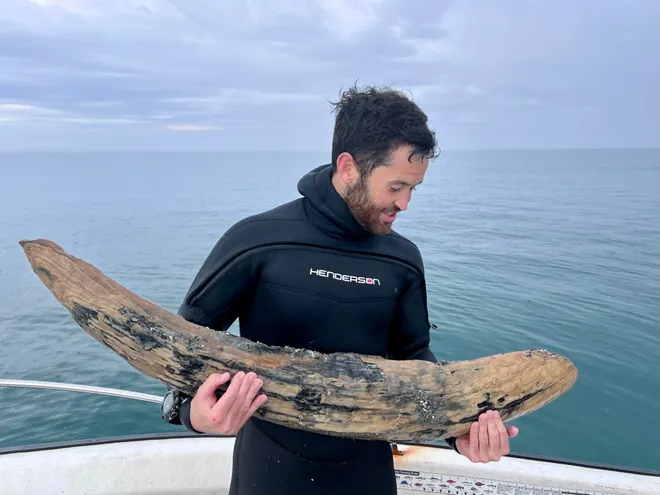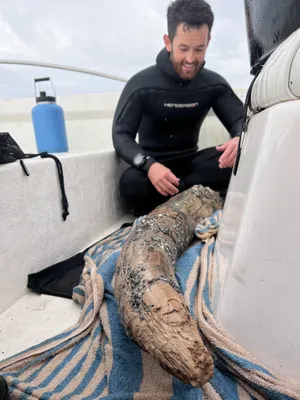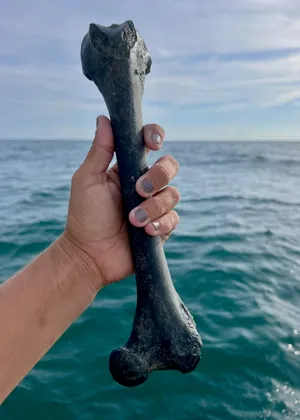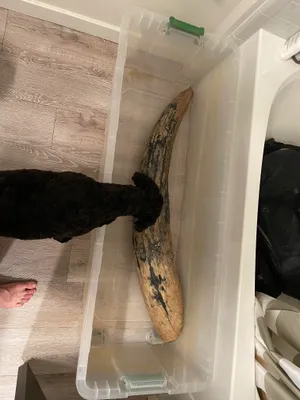Man discovers mastodon tusk while fossil hunting underwater off Florida coast

A Florida man discovered a 4-foot mastodon tusk at the bottom of the ocean while searching for fossils near the coast of Venice.
Alex Lundberg, 29, works in research at a cancer hospital in Tampa on weekdays, but come the weekend, he is a scuba diver and amateur fossil hunter who drives an hour south to Venice Beach to stay at his parents' house and search for prehistoric objects in the waters nearby.
"I'm kind of a weekend warrior," Lundberg told USA TODAY.
He discovered the tusk in April when he went diving with his friend, and only recently unveiled his find to the world.
"I look over, and I see what looks like a 6-inch piece of wood uncovered in the sand, and I swim over to it, and I started fanning it, trying to get the sand off of it," said Lundberg. "It just kept getting bigger and bigger."
He uncovered the cross-section and realized it was a tusk that was a foot wide, four feet long and weighed about 60 pounds.
"It was absolutely crazy," said Lundberg.

A rare discovery
According to Lundberg, it isn't uncommon to find broken pieces or small sections of mammoth tusks (slightly different from mastodons) off of Venice.
"We call it mammoth bark because it just looks like a piece of tree bark," said the fossil hunter.
But to find a whole tusk is "super rare."
"Only a handful of ever come out of Venice," said Lundberg.
The fossil hunter added that his friend found an eight-foot tusk in the same area three years ago.
Previous fossil discoveries
Lundberg said this is definitely one of the coolest fossils he's found, but a runner-up is the jaguar femur he found in the same area a few months before.
"So that was my highlight up until the tusk," said Lundberg.

The amateur fossil hunter got into the hobby when he was a kid, when his dad would take him to construction sites and let him loose to rifle through the dirt the construction crew had just dug through.
Fossil hunting "kind of just stuck with me ever since," said Lundberg.
Today, years after he explored those construction sites, Lundberg said he dreams of finding a saber tooth tiger skull one day.
"That's like the king of Florida fossil hunting," said Lundberg.
Next step
Now, Lundberg will have to report his findings to the Florida Museum of Natural History. From there, the museum will decide if it's scientifically significant. If it isn't, the museum will allow him to keep the tusk.

Lundberg believes he will be able to keep it.
"It's just been kind of rolling around on the ocean floor for at least the last 10 million years," said Lundberg. "Its scientific value is limited, it's just more of a cool display piece at this point."
And that's exactly what he plans to do with it if he does get to keep it.
Lundberg estimates its value to be around $5,000, but that doesn't matter to him.
"I'm never gonna sell it," said Lundberg. "It's gonna stay with me ... As far as I'm concerned, it's priceless"

Julia is a trending reporter for USA TODAY. She has covered various topics, from local businesses and government in her hometown, Miami, to tech and pop culture. You can connect with her on LinkedIn or follow her on X, formerly Twitter, Instagram and TikTok: @juliamariegz
Disclaimer: The copyright of this article belongs to the original author. Reposting this article is solely for the purpose of information dissemination and does not constitute any investment advice. If there is any infringement, please contact us immediately. We will make corrections or deletions as necessary. Thank you.




